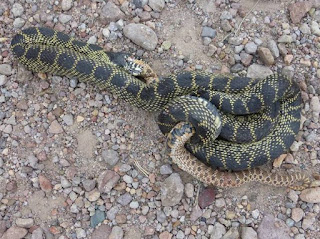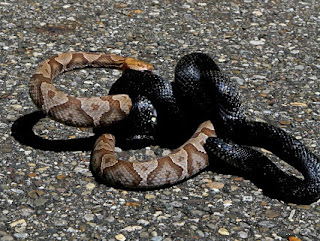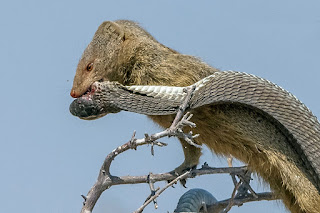![]() |
| A kingsnake eating a western diamondback rattlesnake |
Kingsnakes get their name because they eat other snakes, including venomous snakes like copperheads, cottonmouths, and rattlesnakes. They also eat lots of other kinds of prey, including non-venomous snakes, lizards, turtle eggs, and small mammals.
You often hear people say that kingsnakes are
resistant or
immune to the venom of copperheads, cottonmouths, and rattlesnakes. There is a subtle difference between the meaning of these two words.
Resistance is any physiological ability to tolerate or counteract the effects of a toxin or disease. Like many things in biology, resistance is not an all-or-nothing status, but a gradient. High enough resistance can result in immunity, where the toxin or disease has negligible or no effects.
![]() |
| A kingsnake eating a cottonmouth |
Individuals can acquire resistance through repeated exposure to low doses of a toxin. The immune system recognizes the toxin as foreign and attacks it. It forms a memory of each attack and stores the pattern for later, which makes later responses to the same toxin quicker and more effective. If the toxin dose is later increased,
the memory is reinforced & may become stronger. This is how antivenom is made,
how people become resistant to snake venom, and also how vaccines against infectious diseases work.
1
![]() |
| A kingsnake eating a western hognose snake |
Any time a weapon appears, there is potential for counter-weapons (i.e. resistance and immunity) to appear in response. This happens through a process called a co-evolutionary arms race
2. Just as the United States and the Soviet Union were involved in an arms race centered around nuclear weapons during the Cold War, so are venomous snakes and their prey & predators involved in arms races centered around their primary weapon—venom.
A major difference is that, unlike nations or humans, animals cannot plan for the future and decide to invest more energy in research & development of novel or better weapons technology for future generations. Instead, co-evolutionary arms races happen through natural selection. What start out as tiny variations in toxin resistance can be magnified over many generations.
![]() |
| A kingsnake and a copperhead biting one another |
When vipers were first evolving their front fangs, defensive bites became a new option for them. At first, their predators were probably not very good at resisting the effects of the venom, especially if the predator’s physiology was similar to that of their prey, and venom would have made a very good defense mechanism. Vipers would sometimes be killed and eaten, but many predators later died from their bites. Kingsnake predators that were slightly better able to tolerate the effects of the venom were more likely to survive. Eventually, all the kingsnakes without these venom resistance traits had been killed by vipers that they tried to eat, and only the resistant ones remained. On the other side, vipers that had venom with toxins that were, for example, slightly more painful or fast-acting, might have been more likely to survive a predatory attack. Thus, the arms race escalates. Vipers also exhibit
flipping, jerking, “body bridging” and other escape behaviors as a defense against kingsnakes—suggesting, since they do not try to bite kingsnakes in defense, that their venom is essentially useless as an anti-kingsnake defense mechanism by now and that kingsnakes have “won” this arms race.
![]() |
| A mongoose eating a boomslang |
This is why kingsnakes are immune to the venom of copperheads, cottonmouths, and North American rattlesnakes, but not to the venom of, for example, king cobras or black mambas. Because they live on different continents, there has never been an opportunity for kingsnakes and black mambas to enter into a co-evolutionary arms race (although both prey and predators of black mambas in Africa, such as
honey badgers, and of king cobras in India, such as
mongeese, have probably accomplished much the same thing).
Kingsnakes also eat coralsnakes, but amazingly they are not immune to the venom of Eastern Coralsnakes (
Micrurus fulvius)—kingsnakes injected with coralsnake venom die quickly, and kingsnake blood is
0% effective at neutralizing venom proteins from coralsnakes. Presumably they are able to catch and consume coralsnakes without getting bitten. This could be because coralsnakes often eat other snakes, so perhaps their venom is more difficult for kingsnakes to evolve resistance against. Or, perhaps coralsnakes are rare or dangerous prey for kingsnakes, and it’s possible but not worth it for them to evolve resistance.
![]() |
| A milksnake constricting a Dekay's brownsnake |
Not every kingsnake species has been tested against every venom, but we do know that there is variation in which species are immune to which venoms.
The only study to compare species in depth injected mice with mixtures of venom & snake blood and measured mouse symptoms and survival. They found that blood from Eastern Kingsnakes (
Lampropeltis getula) had the widest spectrum of protection against the venoms tested and was the most effective at neutralizing many rattlesnake venoms, but the least effective against copperhead venom. Blood from kingsnakes from Florida & the Gulf Coast was the most effective at neutralizing the venom of copperheads & cottonmouths.
Mole Kingsnake (
Lampropeltis calligaster) blood is about 75% as effective at neutralizing Mojave Rattlesnake (
Crotalus scutulatus) venom as the blood of Eastern Kingsnakes. Gray-banded Kingsnakes (
L. alterna) have moderate neutralization potential against Western Diamondback (
C. atrox) venom, but none against Eastern Diamondback (
C. adamanteus) venom. Blood from milksnakes (formerly all called
L. triangulum) from various locations had intermediate neutralization capacity, with blood from North American milksnakes being about 70% more effective against rattlesnake venom than blood from Central American milksnakes.
Another study found that an eastern milksnake injected with copperhead venom died, and one injected with pigmy rattlesnake venom had "no noticeable ill effects", but a lack of replication prevents these results from being particularly meaningful. Somewhat surprisingly, blood from Long-nosed Snakes (
Rhinocheilus lecontei), Cornsnakes (
Pantherophis guttatus),
Mussuranas (Clelia clelia), and
Japanese Four-lined Ratsnakes (Elaphe quadrivirgata) was also effective at protecting mice from viper venoms, but blood from pinesnakes (
Pituophis) and gartersnakes (
Thamnophis) was not. Both
vipers and
elapids appear to have at least some level of resistance to their own venom, although detailed studies are lacking for most species.
Kingsnakes are just one of many species that have partial immunity or resistance to venom.
Hedgehogs, skunks,
opossums, and possibly
snake-eagles also have resistance to viper venoms, and
eels are resistant to sea krait venom. Unlike kingsnakes, we have actually
figured out exactly which proteins in opossum blood are responsible for its snake venom neutralization capacity. We also know that mongeese have followed a different route,
changing the shape of the toxin targets in their cells rather than putting molecules into their blood to combat the toxins (
which means that their immunity cannot be transferred). Other predators of venomous snakes,
such as indigo snakes (genus Drymarchon), appear to have gotten away with not evolving immunity, although I was unable to find any actual data on physiological responses of indigo snakes to venom, just statements saying they were not resistant, so it's possible that actual tests have not been carried out.
![]() |
| A mountain kingsnake constricting a skink |
Opossum resistance to copperhead venom probably evolved in a similar way to kingsnake resistance, but vipers are also involved in co-evolutionary arms races with their prey. Many rodent prey of North American vipers are resistant, including
wood rats,
prairie voles, and
ground squirrels. Think of how the U.S. during the Cold War had to balance foreign policy not just with the Soviet Union, but also with other nations. The emerging foreign policy is a compromise, just as the venom that evolves is a compromise of selection pressures from predators and prey. Resistant prey may select for venoms that are better at quickly incapacitating, whereas resistant predators may select for venoms that are less deadly and more painful; it’s difficult to predict exactly what will happen without knowing the exact mechanism of resistance. Sometimes s
election from predators and prey may act in the same direction, other times in opposite directions. The details of these processes are what evolutionary biologists study on a day-to-day basis.
1 Creating a vaccine against snake venom is harder than creating one against an infectious disease that is caused by a virus or a bacterium. There are pit viper venom vaccines available for dogs and horses, made from the venom of Western Diamondback Rattlesnakes, but none are available for humans. Additionally, the canine vaccines must be given twice per year, immediate veterinary care is still required, & protection against other species of venomous snakes is poor, so the technology has a long way to go.↩
2 The most famous co-evolutionary arms race is between toxin-resistant gartersnakes & tetrodotoxin-defended newts in the Pacific Northwest of the US & Canada, although there are many others, such as that between most pathogens & the immune systems of their hosts, between brood parasites such as cuckoos & their hosts, and between bad-tasting plants and herbivores.↩
ACKNOWLEDGMENTS
REFERENCES
![]() |
| A kingsnake eating a ringneck snake |
Barchan, D., S. Kachalsky, D. Neumann, Z. Vogel, M. Ovadia, E. Kochva, and S. Fuchs. 1992. How the mongoose can fight the snake: the binding site of the mongoose acetylcholine receptor. Proceedings of the National Academy of Sciences 89:7717-7721 <full-text>
Bdolah, A., E. Kochva, M. Ovadia, S. Kinamon and Z. Wollberg. 1997. Resistance of the egyptian mongoose to sarafotoxins. Toxicon 35:1251-1261 <abstract>
Bonnett, D. E. and S. I. Guttman. 1971. Inhibition of moccasin (Agkistrodon piscivoris) venom proteolytic activity by the serum of the Florida king snake (Lampropeltis getulus floridana). Toxicon 9:417-425 <abstract>
Carpenter, C. C. and J. C. Gillingham. 1975. Postural responses to kingsnakes by crotaline snakes. Herpetologica 31:293-302 <PDF>
Cates, C. C., E. V. Valore, M. A. Couto, G. W. Lawson, and J. G. McCabe. 2015. Comparison of the protective effect of a commercially available western diamondback rattlesnake toxoid vaccine for dogs against envenomation of mice with western diamondback rattlesnake (Crotalus atrox), northern Pacific rattlesnake (Crotalus oreganus oreganus), and southern Pacific rattlesnake (Crotalus oreganus helleri) venom. American Journal of Veterinary Research 76:272-279 <PDF>
Darawshi, S., U. Motro, and Y. Leshem. 2006. The ecology of the Short-toed Eagle (Circaetus gallicus) in the Judean Slopes Israel. The Rufford Foundation, RSG project, detailed final report <project>
de Wit, C. A. 1982. Resistance of the prairie vole (Microtus ochrogaster) and the woodrat (Neotoma floridana), in Kansas, to venom of the Osage copperhead (Agkistrodon contortrix phaeogaster). Toxicon 20:709-714 <abstract>
de Wit, C. A. and B. R. Weström. 1987. Venom resistance in the hedgehog, Erinaceus europaeus: purification and identification of macroglobulin inhibitors as plasma antihemorrhagic factors. Toxicon 25:315-323 <abstract>
Drabeck, D. H., A. M. Dean, and S. A. Jansa. 2015. Why the honey badger don't care: Convergent evolution of venom-targeted nicotinic acetylcholine receptors in mammals that survive venomous snake bites. Toxicon 99:68-72 <academia.edu>
Heatwole, H. and J. Powell. 1998. Resistance of eels (Gymnothorax) to the venom of sea kraits (Laticaudacolubrina): a test of coevolution. Toxicon 36:619-625 <PDF>
Holding, M. L., D. H. Drabeck, S. A. Jansa, and H. L. Gibbs. 2016. Venom Resistance as a Model for Understanding the Molecular Basis of Complex Coevolutionary Adaptations. Integrative and Comparative Biology 10.1093/icb/icw082 <full-text>
Jansa, S. A. and R. S. Voss. 2011. Adaptive evolution of the venom-targeted vWF protein in opossums that eat pitvipers. PLoS ONE 6:e20997 <full-text>
Keegan, H. L. and T. F. Andrews. 1942. Effects of crotalid venom on North American snakes. Copeia 1942:251-254 <PDF>
Keegan, H. L. 1944. Indigo snakes feeding upon poisonous snakes. Copeia 1944:59 <PDF>
Liu, Y.-B. and K. Xu. 1990. Lack of the blocking effect of cobrotoxin from Naja naja atra venom on neuromuscular transmission in isolated nerve muscle preparations from poisonous and non-poisonous snakes. Toxicon 28:1071-1076 <abstract>
Lomonte, B., L. Cerdas, J. Gené, and J. Gutierrez. 1982. Neutralization of local effects of the terciopelo (Bothrops asper) venom by blood serum of the colubrid snake Clelia clelia. Toxicon 20:571-579 <abstract>
Moussatché, H. and J. Perales. 1989. Factors underlying the natural resistance of animals against snake venoms. Memorias do Instituto Oswaldo Cruz 84:391-394 <PDF>
Neves-Ferreira, A. G., N. Cardinale, S. L. Rocha, J. Perales, and G. B. Domont. 2000. Isolation and characterization of DM40 and DM43, two snake venom metalloproteinase inhibitors from Didelphis marsupialis serum. Biochimica et Biophysica Acta (BBA)-General Subjects 1474:309-320 <abstract>
Nichol, A. A., V. Douglas, and L. Peck. 1933. On the immunity of rattlesnakes to their venom. Copeia 1933:211-213 <PDF>
Ovadia, M. and E. Kochva. 1977. Neutralization of Viperidae and Elapidae snake venoms by sera of different animals. Toxicon 15:541-547 <abstract>
Perez, J. C., W. C. Haws, V. E. Garcia, and B. M. Jennings III. 1978. Resistance of warm-blooded animals to snake venoms. Toxicon 16:375-383 <abstract>
Perez, J. C., W. C. Haws, and C. H. Hatch. 1978. Resistance of woodrats (Neotoma micropus) to Crotalus atrox venom. Toxicon 16:198-200 <abstract>
Perez, J. C., S. Pichyangkul, and V. E. Garcia. 1979. The resistance of three species of warm-blooded animals to western diamondback rattlesnake (Crotalus atrox) venom. Toxicon 17:601-607 <abstract>
Philpot, V. 1954. Neutralization of snake venom in vitro by serum from the nonvenomous Japanese snake Elaphe quadrivirgata. Herpetologica 10:158-160 <PDF>
Philpot, V. and R. G. Smith. 1950. Neutralization of pit viper venom by king snake serum. Experimental Biology and Medicine 74:521-523 <abstract>
Philpot, V. B., E. Ezekiel, Y. Laseter, R. G. Yaeger, and R. L. Stjernholm. 1978. Neutralization of crotalid venoms by fractions from snake sera. Toxicon 16:603-609 <abstract>
Poran, N. S., R. G. Coss, and E. Benjamini. 1987. Resistance of California ground squirrels (Spermophilus beecheyi) to the venom of the northern Pacific rattlesnake (Crotalus viridis oreganus): a study of adaptive variation. Toxicon 25:767-777 <abstract>
Swanson, P. L. 1946. Effects of snake venoms on snakes. Copeia 1946:242-249 <full-text>
Voss, R. S. and S. A. Jansa. 2012. Snake-venom resistance as a mammalian trophic adaptation: lessons from didelphid marsupials. Biological Reviews 87:822-837 <PDF>
Weinstein, S. A., C. F. DeWitt, and L. A. Smith. 1992. Variability of venom-neutralizing properties of serum from snakes of the colubrid genus Lampropeltis. Journal of Herpetology 26:452-461 <PDF>
Weldon, P. J. 1982. Responses to ophiophagous snakes by snakes of the genus Thamnophis. Copeia 1982:788-794 <PDF>
Weldon, P. J. and G. M. Burghardt. 1979. The ophiophage defensive response in crotaline snakes: extension to new taxa. Journal of Chemical Ecology 5:141-151 <PDF>
Weldon, P. J. and F. M. Schell. 1984. Responses by king snakes (Lampropeltis getulus) to chemicals from colubrid and crotaline snakes. Journal of Chemical Ecology 10:1509-1520 <ResearchGate>
Werner, R. M. and J. A. Vick. 1977. Resistance of the opossum (Didelphis virginiana) to envenomation by snakes of the family Crotalidae. Toxicon 15:29-32 <PDF>
Wilcox, C. 2016. Venomous: How Earth's Deadliest Creatures Mastered Biochemistry. Scientific American. <official page>
Witsil, A. J., R. J. Wells, C. Woods, and S. Rao. 2015. 272 cases of rattlesnake envenomation in dogs: Demographics and treatment including safety of F(ab')2 antivenom use in 236 patients. Toxicon 105:19-26 <abstract> 








